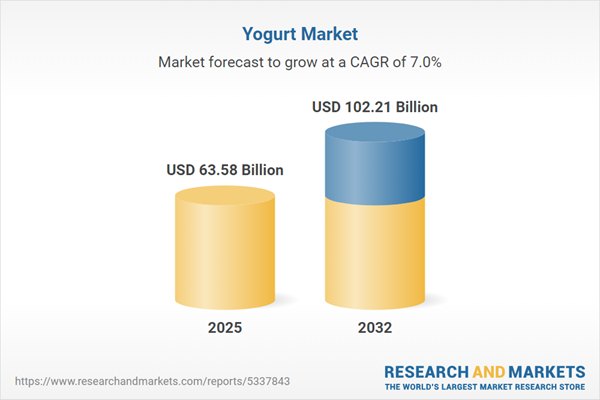Speak directly to the analyst to clarify any post sales queries you may have.
The U.S. yogurt market is rapidly transforming, shaped by evolving consumer expectations, regulatory adjustments, and increased sustainability efforts. This shifting environment compels business leaders to develop more adaptive strategies for growth and resilience.
Market Snapshot: U.S. Yogurt Market Trends and Growth Outlook
The global yogurt market is forecasted to reach USD 63.58 billion in 2025, up from USD 59.44 billion in 2024, reflecting a 7.00% CAGR, with expectations of achieving USD 102.21 billion by 2032. This expansion is underpinned by changing consumer health priorities, ongoing product development, and the adoption of omnichannel retail. Established brands and emerging players redesign strategies to address shifting loyalty trends and demographic influences. These factors, together with digital transformation and tailored product offerings, continue to reinforce the sector’s adaptability amidst evolving market dynamics.
Scope & Segmentation: U.S. Yogurt Market Overview
This analysis provides executives with focused insights to inform B2B decision-making. The segmentation framework highlights the following:
- Product Types: Assessment includes flavored and non-flavored yogurts, with analysis of shifting consumer interests in traditional versus innovative yogurt segments.
- Packaging Formats: Considers cup, drinkable, multipack, and pouch formats, evaluating their influence on consumer convenience, brand differentiation, and operational logistics.
- Flavor Profiles: Explores established options like plain or strawberry and new, seasonal launches catering to regional preferences and innovation-driven demand.
- Fat Content: Addresses non fat, low fat, and whole fat varieties to reflect the market’s focus on both wellness and indulgent consumption drivers.
- Distribution Channels: Analyzes both online and in-store retail, with an emphasis on the impact of omnichannel approaches on consumer engagement and channel optimization.
- Geographies: Encompasses global regions, with targeted reviews of key markets including the United States, China, and India.
- Key Players: Examines the landscape incorporating Danone S.A., Inner Mongolia Yili, Nestlé S.A., General Mills, Groupe Lactalis, Müller Holding, Chobani LLC, Yakult Honsha, Arla Foods amba, and Grupo Lala to highlight strategic partnerships, competition, and collaborative trends.
Key Takeaways for Senior Decision-Makers
- Consumer preferences continue to grow for both plant-based and dairy-based yogurts that include health-centric probiotics and highly visible ingredient disclosures, creating space for ongoing product launches.
- Integration of advanced manufacturing and digital monitoring contributes to maintaining strict quality control and enables swift shifts across expanding distribution networks, improving overall efficiency.
- Omnichannel retail strategies drive more customized customer experiences, enhance engagement through both digital and physical touchpoints, and introduce flexibility in inventory management and distribution.
- Packaging innovation, especially in recyclable designs and lightweight materials, helps companies progress toward corporate sustainability objectives and better connect with environmentally conscious buyers.
- Collaboration with biotechnology firms and strategic acquisitions are key for accelerating innovation cycles, supporting companies’ ability to react to changing market needs and competitive pressures.
Tariff Impact: Adapting to Shifting Trade Policy
With new U.S. tariffs scheduled for 2025, yogurt producers are reassessing supply chain models, placing priority on efficient sourcing and packaging procurement. Flexible procurement and closer supplier integration are becoming essential to cost management and risk mitigation. Utilizing scenario-based analysis and dynamic pricing strategies helps businesses address regulatory uncertainty and maintain continuity amid shifting operational environments.
Methodology & Data Sources
This report is built around primary interviews with industry executives and product specialists, supplemented with independent expert input and robust secondary research. All data and findings are subject to rigorous validation processes, ensuring a reliable reference for decision-makers.
Why This Report Matters
- Equips senior executives with timely insights to recognize emerging demand trends, guide innovation strategy, and capitalize on new, scalable market opportunities in the yogurt sector.
- Provides structured guidance for proactive risk management in anticipation of evolving global trade policy and regulatory scenarios.
- Enhances portfolio diversification and helps align sustainability programs, supporting more successful market positioning across varying demographics and geographic regions.
Conclusion
This report delivers targeted, actionable guidance for senior decision-makers seeking to strengthen market strategies, foster innovation, and effectively address regulatory challenges in the U.S. yogurt market.
Additional Product Information:
- Purchase of this report includes 1 year online access with quarterly updates.
- This report can be updated on request. Please contact our Customer Experience team using the Ask a Question widget on our website.
Table of Contents
3. Executive Summary
4. Market Overview
7. Cumulative Impact of Artificial Intelligence 2025
Companies Mentioned
The companies profiled in this Yogurt market report include:- Danone S.A.
- Inner Mongolia Yili Industrial Group Co., Ltd.
- Nestlé S.A.
- General Mills, Inc.
- Groupe Lactalis
- Müller Holding GmbH & Co. KG
- Chobani LLC
- Yakult Honsha Co., Ltd.
- Arla Foods amba
- Grupo Lala, S.A.B. de C.V.
Table Information
| Report Attribute | Details |
|---|---|
| No. of Pages | 185 |
| Published | November 2025 |
| Forecast Period | 2025 - 2032 |
| Estimated Market Value ( USD | $ 63.58 Billion |
| Forecasted Market Value ( USD | $ 102.21 Billion |
| Compound Annual Growth Rate | 7.0% |
| Regions Covered | Global |
| No. of Companies Mentioned | 11 |









